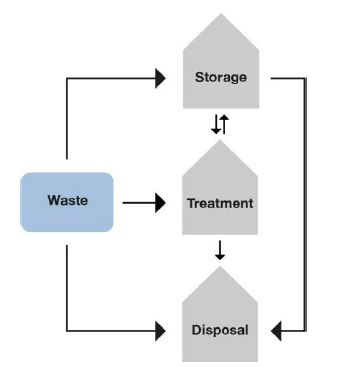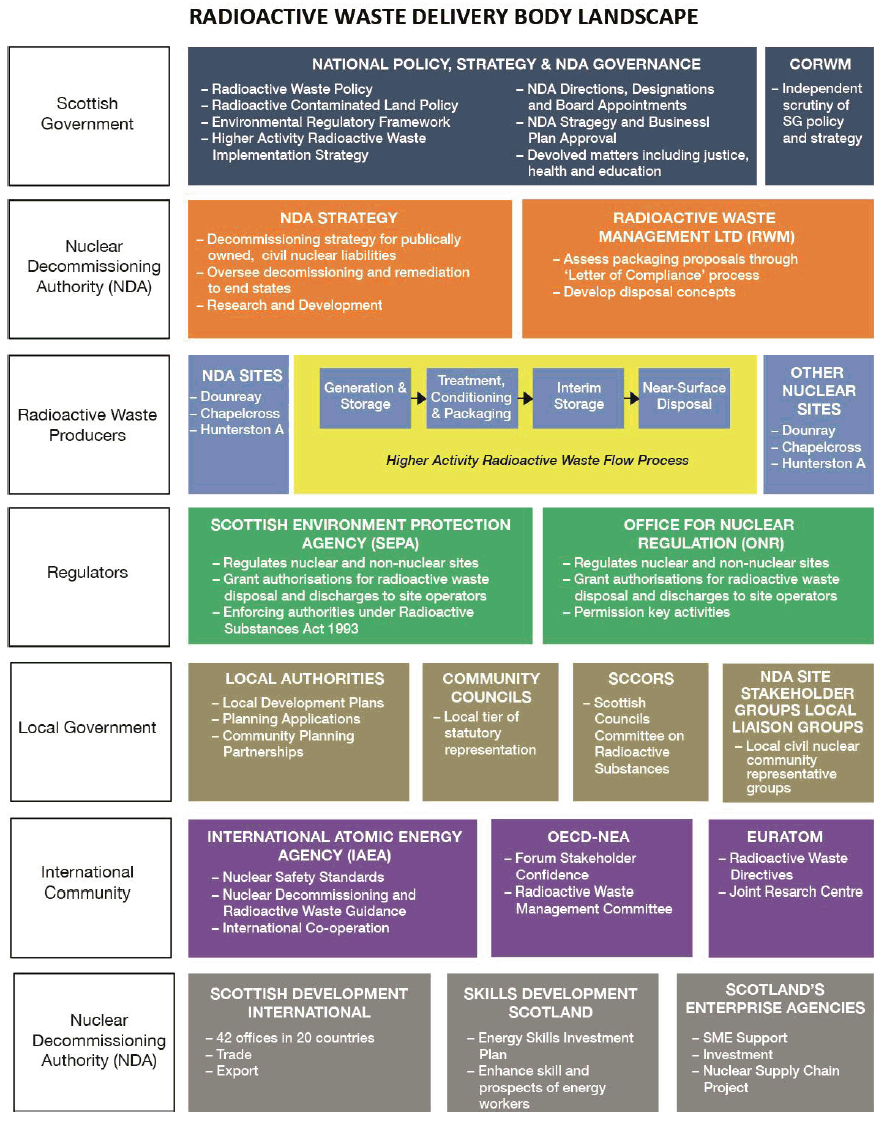Higher-activity radioactive waste: implementation strategy
Implementation strategy for Scotland's policy on higher-activity radioactive waste.
1 Background to the Implementation Strategy
1.1 The Policy, a Summary
1.1.1 The Scottish Government published its Policy Statement for Higher Activity Radioactive Waste in January 2011 ("the 2011 Policy") [1] .
1.1.2 The Scottish Government Policy is that long-term management of Higher Activity Radioactive Waste ( HAW) should be in near-surface facilities. Facilities should be located as near to the site where the waste is produced as possible. Developers will need to demonstrate how the facilities will be monitored and how waste packages, or waste could be retrieved. All long-term waste management options will be subject to robust regulatory control.
1.1.3 The Scottish Government's Policy is set in the context of the latest European Directive on Radioactive Waste (2011/70/Euratom) which states that the typical disposal concept for low and intermediate-level waste is near-surface disposal [2] .
1.1.4 The Directive also calls for the planning and implementation of disposal options as a part of national policies for all radioactive wastes, while recognising that plans need to remain flexible in the light of developing knowledge.
1.1.5 The 2011 Policy provides the framework for the long-term management of higher activity radioactive waste arising in Scotland. The aim of the Policy is to ensure that all activities for the long-term management of the waste are made in a way that protects the health and interests of people and the integrity of the environment now and in the future. The Policy stated that:
a) The Policy is not prescriptive in its approach, recognising that it will be applicable to waste:
- which may not be produced for decades; and
- for which long-term management options may not be feasible at present or have yet to be developed.
b) The Policy provides the framework within which regulators, facility operators, waste producers and owners and the NDA will take decisions on the long-term management of the waste and undertake the work, and duties, for which they are responsible. The Policy enables options to be considered which may require research or development, recognising that advances may be made over time to manage waste for which long-term options are not current feasible.
c) The Policy allows waste producers and owners to consider long-term management options for:
- waste treatment, including sending it to another location for treatment, either in Scotland or elsewhere including overseas, subject to any requirements by the relevant regulators in the UK and overseas for the return of the waste;
- storage in near-surface facilities which are near to the site where waste is produced; or
- disposal in near-surface facilities which are near to the site where the waste is produced.
Figure 1: waste management options

1.1.6 For the purposes of the Policy and Strategy, disposal is defined as placing waste in a suitable specialised land-based facility without the intent to retrieve it at a later time. Although there is no intention to retrieve the waste, any proposed disposal facilities in Scotland will have to demonstrate 'retrievability'. Retrievability means that, if necessary, waste could be removed from the facility at a later time.
1.1.7 The 2011 Policy will be subject to regular review at intervals of no more than 10 years. The Strategy will be reviewed at the same time as the Policy. This recognises that some long-term management options may require extensive research or development, and that new scientific advances and technological developments are likely to occur over time. It is important to ensure that Scotland is able to consider such innovations in future, to assess whether they provide new and better methods of managing radioactive waste than are available at present. The process to develop the Implementation Strategy has in practice reviewed the 2011 Policy, updating information on the inventory, available technologies and changing site plans. For this reason, the next review of the Policy and Strategy will take place no more than 10 years from the publication of this Strategy.
1.1.8 The terms used in this Strategy document have the same definition and meaning as those used in the 2011 Policy. Key definitions are set out in Annex A , including a definition of higher activity waste. A fuller glossary of terms was provided as a supplementary document to the 2011 Policy [3] .
1.1.9 The HAW covered by the 2011 Policy and this Strategy is summarised in Annex B . The Policy does not apply to waste from MoD sites that are exempt from regulation under the Radioactive Substances Act 1993.
1.2 Roles and Responsibilities
1.2.1 The Scottish Government is responsible for the implementation of policy and legislation on devolved matters, including the protection of the environment, and radioactive waste management in Scotland. The Scottish Government makes proposals to the Scottish Parliament for changes to the law and regulation covering these policy responsibilities.
1.2.2 The Nuclear Decommissioning Authority ( NDA) is a non-departmental public body established by the Energy Act 2004. The NDA is responsible for implementing government policy on the long-term management of radioactive waste. The NDA is additionally responsible for the decommissioning and clean-up of existing publicly owned civil nuclear sites, including three in Scotland (Dounreay, Chapelcross and Hunterston A). The NDA operates in similar terms to a cross-border authority under the Scotland Act 1998 and is accountable to both the UK and Scottish Ministers for its activities and performance with regards to Scotland. The NDA is also responsible for developing a strategic research and development programme.
1.2.3 The Scottish Environment Protection Agency ( SEPA) is Scotland's environmental regulator responsible for regulating the disposal of radioactive waste and discharges from nuclear and non-nuclear sites in Scotland. In addition, for non-nuclear sites, SEPA regulates the keeping and use of radioactive substances and the accumulation of radioactive waste.
1.2.4 The Office for Nuclear Regulation ( ONR) is the body responsible for regulating the safety and security of the UK's civil nuclear industry. ONR issues nuclear site licences to site operators under the Nuclear Installations Act 1965. Additional responsibilities include the regulation of the management of radioactive waste under site licence conditions and regulating the safety of transport of radioactive materials.
1.2.5 The Committee on Radioactive Waste Management ( CoRWM) provides independent scrutiny and advice to the Scottish Government on the long-term management of higher activity radioactive wastes.
Figure 2: Scotland's civil nuclear and radioactive waste landscape

1.2.6 Waste owners are responsible for safely storing higher activity wastes during decommissioning processes and for making provision, including financial provision, in their plans for long-term management of the waste they produce. It is for individual organisations to consider how they apply the 2011 Policy in their forward planning assumptions. Waste owners include:
(i) the NDA and their Site Licence Companies ( SLC);
(ii) EDF Energy;
(iii) Ministry of Defence; and
(iv) Non-nuclear sector organisations.
1.2.7 EDF Energy makes financial provision for waste management and decommissioning of sites via the Nuclear Liabilities Fund. The NDA is directly funded by the UK Government as all existing public sector nuclear sites are public liabilities. Therefore the costs of decommissioning these sites will be met in full by the UK Government.
1.2.8 The Scottish Government will work with the NDA, EDF Energy and the Nuclear Liabilities Fund to ensure that consideration of costs for the implementation of this Strategy, including near-surface disposal options, form a part of the assessment of the adequacy of the Fund.
1.2.9 Waste producers are nuclear and non-nuclear organisations who produce higher activity radioactive wastes. These companies may or may not be the same as waste owners. Nuclear waste producers in the nuclear sector are typically nuclear site operators.
1.2.10 Annex B contains further information about the NDA owned sites and the other main waste owners in Scotland.
1.3 Regulatory Framework
1.3.1 There is already a comprehensive and well-established legislative, regulatory and planning framework in place in Scotland for the management of higher activity radioactive waste and the development of waste management facilities. Robust, effective and independent regulation is vital to ensure public confidence in the management of higher activity radioactive waste to meet high safety, security and environmental standards based on comprehensive risk assessment and management. The legislative framework is described in a supplementary document to the 2011 Policy [4] .
1.3.2 The Regulatory Reform (Scotland) Act 2014 enables provision to be made in relation to primary authorities and for the purposes of promoting regulatory consistency. In addition, it enables provision to be made, and to make provision, as respects regulatory activities, and offences, relating to the environment. The Scottish Environment Protection Agency ( SEPA) was given a new statutory purpose under this Act and new enforcement measures to ensure continued protection for the environment and human health.
1.3.3 The Better Environmental Regulation Programme is currently underway between the Scottish Government and SEPA. This aims to provide a simpler legislative framework so that SEPA can be more transparent, accountable, proportionate, consistent and targeted in carrying out its regulatory functions. This will enable SEPA to better identify, and focus most effort on, the most important environmental risks and harms. This will ensure more effective and efficient protection of the environment, reduce the regulatory burden on business and allow regulators to take opportunities to improve the environment.
1.3.4 The Scottish Government is committed to strong and effective control and regulation of the management of higher activity radioactive waste in Scotland. Regulators, waste producers, waste owners and others involved in the management of higher activity radioactive waste in Scotland are expected to take account of Scottish Government Policy.
1.4 Strategic Environmental Assessment
1.4.1The 2011 Policy stated that the Strategy developed to implement the Policy would be subject to a Strategic Environmental Assessment ( SEA). At the time the Policy was published, it was predicted that the Strategy would develop further spatial components than outlined in the Policy, and that there may be the potential for the Strategy to have environmental effects. As the Strategy has evolved, however, it has become clear that while it sets out the strategic path for delivering the Policy and the nature and timing of key decisions, it does not further develop the spatial aspects of HAW management. As a consequence, this Strategy is not considered likely to generate significant environmental effects, beyond those already considered and assessed by the SEA of the 2011 Policy.
1.4.2A Screening Report was issued to this effect [5] , and the Consultation Authorities agreed that significant environmental effects were unlikely. However, the requirement for SEA of the Strategy continued to be reviewed as the Strategy developed, in case this situation changed.
1.4.3No changes to the Strategy have been made that could result in such effects. As such, a Screening Determination for the Strategy was issued in May 2014 confirming that the Strategy is not likely to have significant environmental effects when considered in relation to the criteria set out in Schedule 2 of the Environmental Assessment (Scotland) Act 2005. As a consequence, it was determined that a SEA is not required.
1.4.4As in the development of the Strategy, the requirement for SEA will be considered in further stages of work to implement the Policy, including future iterations of the Strategy.
Contact
There is a problem
Thanks for your feedback